Large chain-mail catfish are frequent inhabitants of large aquariums. They are beautiful to look at and are extremely beneficial in eating algal growth in the aquarium. The brocade pterygoplicht, or leopard catfish, will be discussed in our article.
General information
Pterygoplicht brocade (Pterygoplichthys gibbiceps) belongs to the family of chain mail catfish, one of the largest representatives of its genus.
Despite their impressive size, pterygoplichts are peaceful fish. And their gastronomic interest is almost entirely limited to vegetation. These fish are good helpers in the fight against algal fouling on the walls of the aquarium.
They are predominantly nocturnal. When kept with closely related species, clashes are possible, during which an interesting form of behavior is observed – pterygoplichts raise their dorsal fins and spread their pectoral fins in all directions. In nature, fish in this way deceive predators, visually increasing their size.
Under natural conditions, during dry periods, pterygoplichta can bury themselves in the ground and hibernate before the onset of the rainy season. Also, these catfish are characterized by intestinal respiration: with a lack of oxygen, the fish is able to swallow air above the surface of the water and assimilate it with the help of the intestinal circulatory system.
Pterygoplichts can make hissing sounds when pulled out of the water. It is also believed to be an adaptation in order to frighten predators.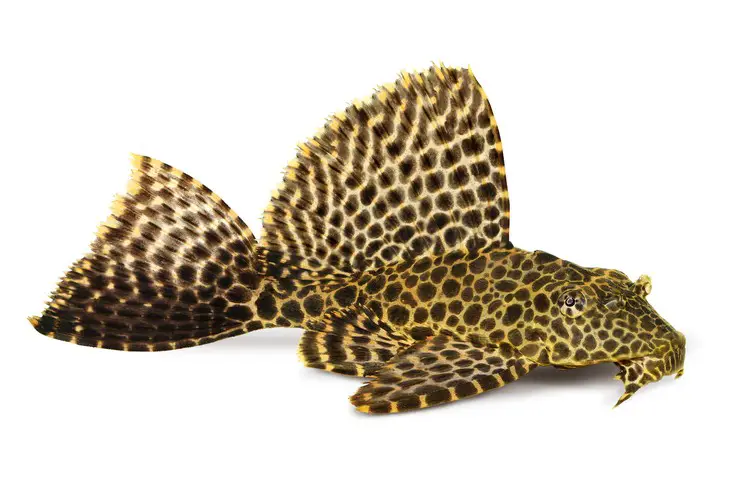
Appearance
The specific name very clearly reflects the distinctive features of the fish. Pterygos – “wings”, hoplon – this was the name of the shield of the ancient Greeks, ichthys – “fish”, gibbiceps – “hump on the head”.
The brocade catfish has an elongated body, slightly flattened at the top. The entire trunk, with the exception of the abdomen, is covered with dense bony plates. The head is large, with characteristic protruding nostrils. The mouth is modified into a large suction cup, with which the fish can be held on vertical surfaces. It is so strong that it is not possible to tear off the fish without damage. Thick antennae are located at the base of the oral suckers.
The eyes are small, located on the top of the head. They are arranged in such a way that the fish sees not only what is happening in front of it, but also capable of observing the situation from behind or from the side. Only the space above the catfish remains in the dead zone.
The dorsal fin is large, sail-shaped, with at least twelve rays. The pectorals resemble wings and are located very close to the abdomen. They are very powerful and help the fish to dig into the ground.
The main body color is chocolate or almost black, with many beige lines creating a pattern reminiscent of leopard skin. With age, it can fade and disappear completely. There are albino forms.
The pectoral fins are also large, composed of thick bones, which helps the catfish to burrow into the ground.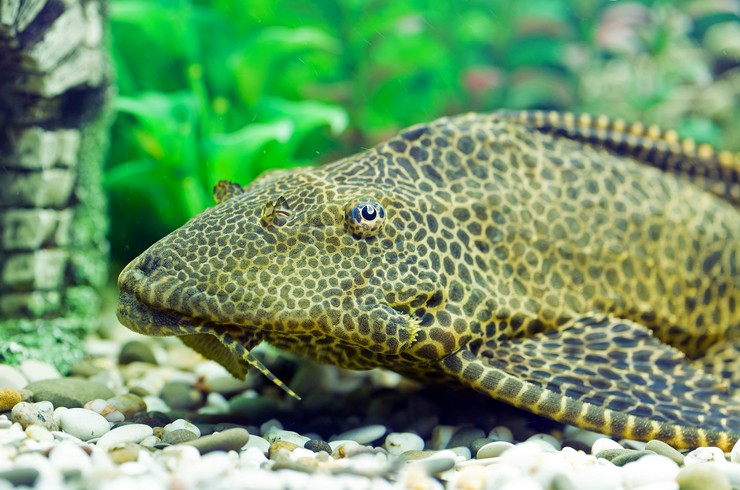
Differences between pterygoplicht and ancistrus
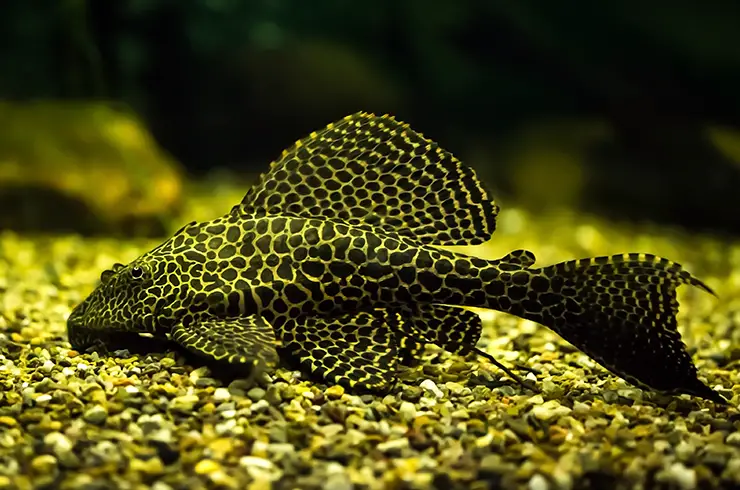
Pterygoplichta and ancistrus are the most popular representatives of the Lorikariev family or Kolchuzhny catfish. At first glance, the fish are very similar, especially if we consider young individuals. However, these two catfish require completely different aquarium volumes to maintain, so it is important to be able to distinguish between these species.
- The first thing to pay attention to is the shape of the body. Looking at the fish from above, you will find that the body of the ancistrus is teardrop-shaped, with a rounded front part, while the pterygoplicht is angular. Something similar is observed when looking at catfish in profile: pterygoplichts have a high body, almost triangular in shape, while in ancitruses it is flattened;
- The maximum size of a pterygoplicht is 50 cm, while ancistrus is much more modest – no more than 15 cm;
- Look closely at the side of the catfish head. The nostrils in pterygoplichts will be located above the eyes, and in ancistrus – below;
- Already from the age of six months, in males of ancistrus, special hook-shaped outgrowths (tentacles) appear on the head. In pterygoplichts, this is not observed, it has only massive whiskers on the lower jaw;
- The dorsal fin of the pterygoplicht is its pride – it is very large and hard, like a sail. The fin of ancistrus is small and rounded;
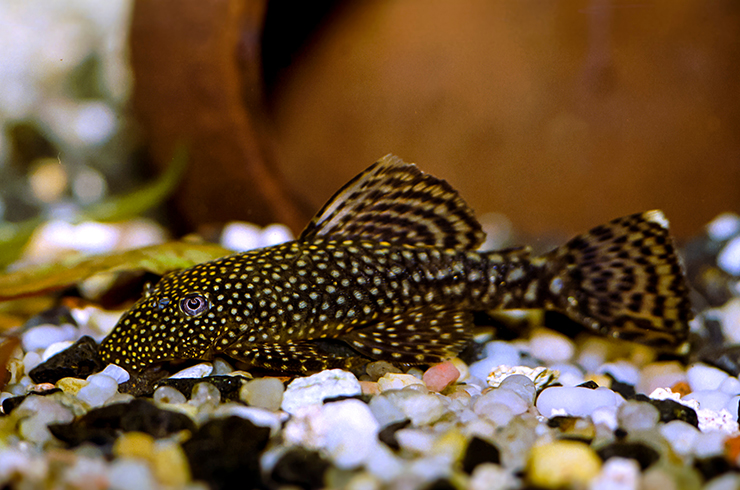
- The color of these two species also differs. Ancistrus has a dark body with small white dots. In pterygoplichts, the body is light, large spots are densely located on it, reminiscent of the pattern of the skin of a leopard;
- In pterygoplichts, gender dimorphism is not expressed. Distinguishing the male ancistrus from the female will not be difficult: it is larger and has a tentacle mustache;
- The lifespan of catfish also differs. Ancistrus live for about 10 years, while larger pterygoplichts live up to 20 years.
Habitat
The homeland of pterygoplichts is South America. They can be found in the Amazon, Orinoco, Brazilian rivers Xingu and Tefe. Fish prefer slow-flowing rivers, settling mainly on shallows in places where there is a lot of silt. They often gather in large groups. During the wet season, they are very active and voracious – they feed on vegetation and carrion. In dry times, they burrow into moist silt and hibernate to survive adverse conditions.
Currently, they are actively bred in Asian countries, from where they are supplied around the world.
Care and maintenance
Pterygoplicht is a very large fish, the minimum volume for keeping one individual is at least 250 liters. Coarse sand or small pebbles are suitable as soil. It is recommended to install a variety of shelters in the aquarium: rock caves, ceramic or plastic pipes. There must be natural driftwood. Eating it, pterygoplichts receive cellulose, which is important for digestion.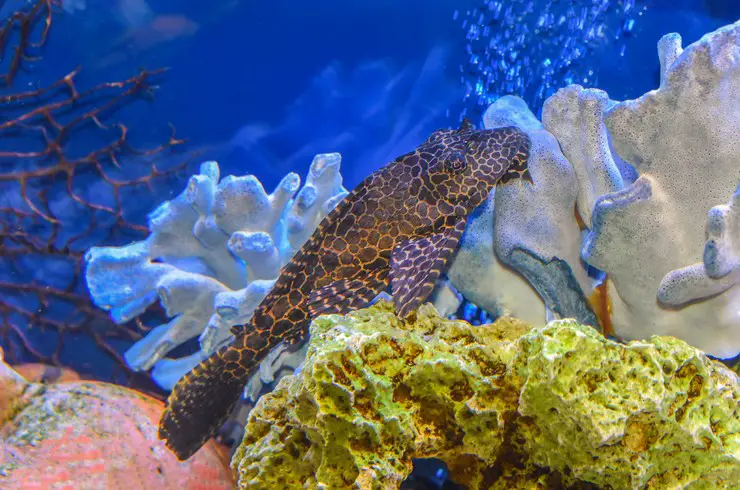
The aquarium should be equipped with a powerful external filter and compressor; fish love clean water saturated with oxygen. It should be noted that intestinal respiration cannot replace aeration. If the pterygoplicht often floats up for a portion of air, then there is a problem with the oxygen content in the aquarium. Also, fish do not like strong currents. We must not forget about weekly (up to 30%) water changes.
When choosing plants, one should take into account the fact that pterygoplichts are able to easily dig up any aquarium plant, so it is better to focus on species that take root well: Cryptocorynes, Aponogetones, Vallisneria. They must be surrounded by stones without fail. If there is a lack of food, plants can suffer.

